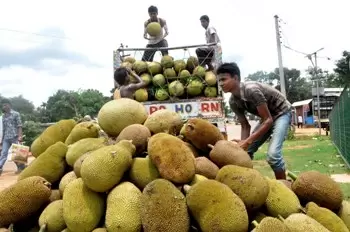The biggest fruit that grows in a tree is consumed, raw or ripe
31-January-2015
Vol 6 | Issue 5
The one thing that anyone travelling across Kerala just cannot miss is the jackfruit tree as it is tall and well spread. On most occasions, one can see the greenish-yellow jackfruit hanging in adequate numbers - not surprising as this is by far the largest tree-borne fruit.
Over the years this fruit still maintains its status as one that is affordable to all and can be consumed raw or ripe. Each jackfruit weighs from three to 30 kilograms.
 |
|
Jackfruits procured from Kerala at the rate of Rs.10 per piece are sold at over Rs.100 in neighbouring Tamil Nadu (Photo: Indian Photo Agency – for representational purpose only)
|
Believed to have originated in the country's southwestern rain forests, the word jackfruit comes from Portuguese jaca, which in turn, is derived from the Malayalam word chakka.
In common parlance, chakka is often referred to as the pre-ripe form and the fragrance of the fleshy jackfruit is first noticed by squirrels and the birds. The ripe form is called chakka pazham.
In Kerala the two most commonly found variety are 'koozha', which is not much in demand as 'varikka' which of late has become a much sought after one.
Molly Thomas, an 80-year-old grandmother from Thiruvalla, said this is one food item that was once the succour of many people, especially the labour class.
"I remember that when work was difficult to come by during the rainy season, my father-in-law used to allow the labour class to cut the near-ripe jackfruit. The mashed jackfruit, prepared with grated coconut and spices, is not only mouth-watering but also quite a filling meal. Also, the tasty chips prepared from jackfruit is a hit among one and all," said Thomas.
The process of weaning out the pieces after cutting open the jackfruit is a laborious one and is very messy because of the sticky white fluid that oozes out, but for experienced people, it's child's play.
The seed or 'chola' inside each fleshy piece is also used for making excellent dishes. One of the most popular ones is when it's mixed with raw mango and coconut paste and for a curry called 'chakkakuru manga' that is eaten with steaming rice.
"When eaten with typical Kerala fish curry, mashed jackfruit is second to none. We have now started promoting this among the foreign tourists who opt for home stays," said Jacob Punnen, who rents out rooms in Kottayam.
Today, the koozha variety is not much in demand and householders find it difficult to dispose it off because after it ripens and falls, it's a big messy affair with lots of flies and birds feeding on it. The varikka variety of a jackfruit is available at a fancy price of Rs.150 upwards.
"We have both varieties of jackfruit. Of late, it's buyers from Tamil Nadu who come and buy the varikka variety. They do not want the koozha variety. They rip us off as while we get around Rs.10 for a varikka jackfruit, we are told that they sell it from above Rs.100.
“If we do not sell it for Rs.10 per piece, then it will become food for the birds and squirrels. Another problem is if we hire a tree-climber to cut the fruit, he asks for at least Rs.250. As a result, even if we get just Rs.10 per piece, we sell it to the buyers from Tamil Nadu," said farmer Sreekantan Nair.
Countries like Thailand, the Philippines and Sri Lanka have taken the jackfruit to the next level by coming with value-added products.
"We lived in Thailand for three years and there are numerous sweet products that are made out of jackfruit. I am surprised that this is not happening in our state. The only notable product that is now available is 'chakka varatiyathu' and that too, the present generation of womenfolk are not as expert as our mothers used to be," sid homemaker Susan Jacob, who spent three years in Thailand.
And last but not the least, while the outer thick skin of the jackfruit is a much sought after feed for cattle, the leaves of the jackfruit tree are equally in demand by goat farmers. - IANS














